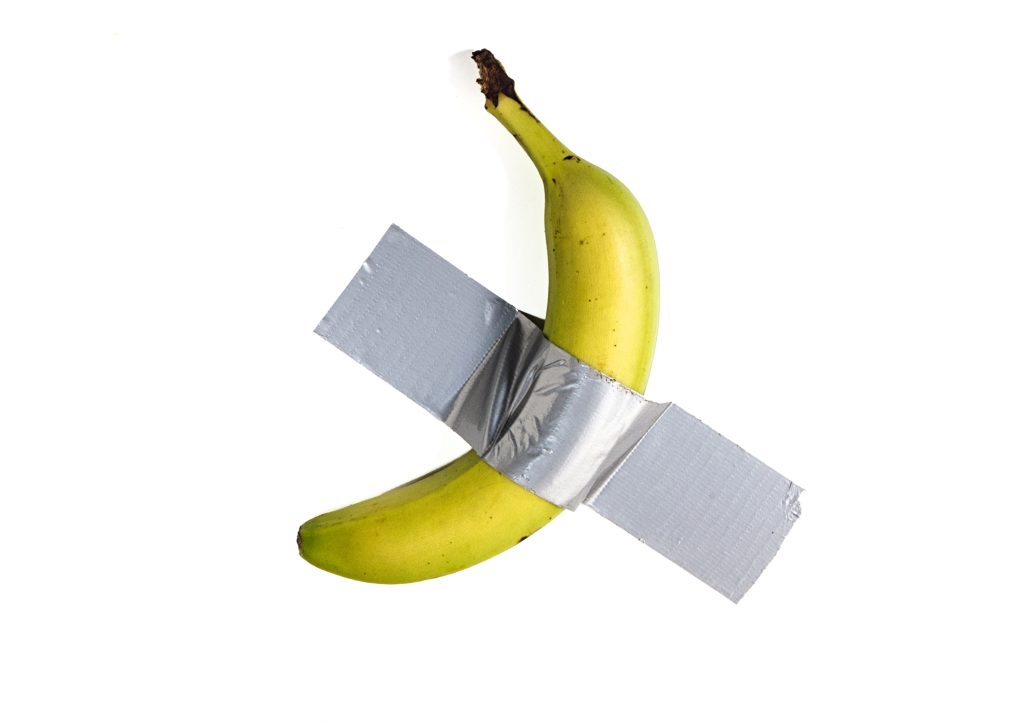Banana taped to a wall using duct tape

This is a parody of the art work ‘Comedian’ by Italian artist Maurizio Cattelan. It’s a banana taped to a wall using duct tape! This seemingly absurd piece of art has garnered significant attention, sparking debates about the nature of art, value, and consumerism in today’s society. Cattelan’s work invites viewers to question what constitutes art and whether the context in which something is presented can elevate its value beyond the physical object itself.
The banana, a common fruit, becomes an emblem of contemporary art’s intersection with humour and satire. It challenges traditional notions of artistry and craftsmanship, encouraging a broader conversation about the role of artists and the art market. Critics have been divided, with some praising Cattelan for his boldness and creativity, while others dismiss it as a cheap gimmick. This controversy only amplifies the banana’s impact on the art scene.
It was sold to cryptocurrency entrepreneur Justin Sun for $6.2 million in November 2024. Soon afterwards, he ate the banana onstage, comparing it to a crypto asset and saying, ‘The real value is the concept itself.’ This statement highlights the growing intersection between digital currencies and the art market, where the value of art is often perceived as both a financial investment and a philosophical concept.
Sun’s actions during the auction not only drew media attention but also sparked discussions about the role of performance in art. By consuming the artwork, he transformed it from a static object into a fleeting moment of experience, mirroring how modern artworks often exist in the realm of social media and viral moments. This act of consumption also raises questions about ownership and the impermanence of art in the digital age.
Furthermore, this incident has led to a surge of interest in similar conceptual artworks, prompting artists to explore new ways of presenting their ideas. The banana has become a cultural reference point, inspiring countless memes and discussions about value, art, and the absurdity of modern life.
In the wake of this event, many artists have begun to experiment with unconventional materials and ideas, drawing parallels between Cattelan’s banana and other notable instances of conceptual art. For instance, the work of Duchamp, particularly his ‘Fountain’ – a urinal presented as art – shares a similar ethos in challenging the boundaries of artistic expression and provocation. Just as Duchamp’s urinal prompted a reevaluation of what art could be, Cattelan’s banana continues to push the envelope, inviting dialogue about creativity and commercialism.
As the art world grapples with the implications of such works, discussions surrounding ownership and authenticity have also intensified. In an era where digital reproductions are rampant, determining the ‘real’ version of a work becomes increasingly complex. This complexity is mirrored in the world of cryptocurrencies, where the concept of value is fluid and often subject to the whims of market demand. The banana, once a mere fruit, now symbolizes the blurring lines between art and investment, authenticity and reproduction, reality and simulation.
Art collectors and investors find themselves at a crossroads, where traditional methods of valuation are challenged by new paradigms. The banana taped to a wall serves as a case study, demonstrating how modern art can be a commentary on society while simultaneously functioning as a commodity. These themes resonate across various domains, including fashion, music, and literature, where the question of value continues to evolve in the face of shifting cultural landscapes.
Moreover, the impact of social media cannot be overstated. Platforms like Instagram and Twitter have revolutionised how art is consumed and appreciated, allowing artists to reach wider audiences without the constraints of traditional galleries. This democratization of art has given rise to new forms of expression and engagement, where even the simplest ideas can capture the public imagination and generate significant discourse.
The banana’s journey from a supermarket shelf to an auction house highlights the often absurd nature of art commerce today. It prompts us to reflect on our own perceptions of value and the societal constructs that dictate what is worthy of admiration. As we continue to navigate this evolving landscape, the lessons from Cattelan’s banana will undoubtedly influence future generations of artists and collectors alike.
